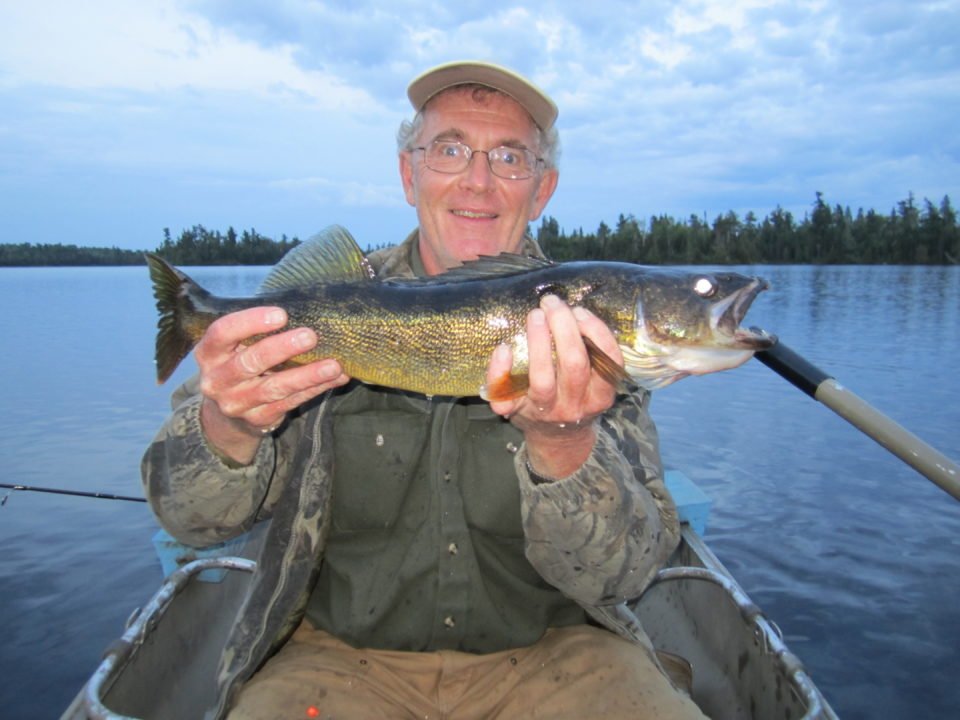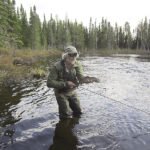“It’s kind of a gray area,” he says.
The earliest written records are from the first loggers and settlers, who were already stocking fish into just about any waters. Stocking fish is somewhat like planting a garden: You dump small fish into the water and see if they survive. Early fish culturists provided fish for stocking, usually as tiny fry or fingerlings that could be transported in milk cans via the railroad. Persons said walleyes, smallmouth bass, northern pike and brook trout were stocked this way in the early 1900s. Actual stocking records weren’t kept until the 1930s.
Only a few species of fish existed in inland lakes prior to settlement. Most lakes contained northern pike, yellow perch and white sucker. Deeper lakes also supported burbot, lake trout and longnose suckers. The only native panfish was the tiny green sunfish. A wide variety of forage fish such as dace and shiners are native, but fathead minnows and golden shiners likely first arrived in bait buckets. A greater variety of fish species existed in Lake Superior, but they were blocked from migrating up tributary rivers to headwater lakes by waterfalls that were barriers to fish passage. Even brook trout, which thrive in North Shore rivers and creeks, were not native above the barriers.
Persons said fish species that “pretty clearly” were not native in Cook County’s inland waters include walleyes, smallmouth bass and rainbow smelt, as well as rainbow and brown trout. He knows ciscoes and lake whitefish were introduced to some lakes, but is uncertain whether native populations existed elsewhere.
Species such as walleyes, smallmouth bass, cisco, brook trout and lake whitefish are native to other Minnesota watersheds, so why weren’t they found in Cook County? As glaciers melted and receded thousands of years ago, they left behind sprawling glacial lakes that drained north, east and south from Minnesota. The fish living in these lakes survived in the “remnant puddles,” as Persons jokingly refers to today’s lakes. Some of those original fish populations can still be found in remote lakes within the Boundary Waters Canoe Area Wilderness.
While an extensive public awareness effort has shown the public the ecological damage that can occur from aquatic invasive species such as the common carp (found in Lake Superior, but not in Cook County’s inland waters), introductions of desirable fish species are usually considered benign. Often, this is not the case.
Consider Poplar, Hungry Jack, Flour and East Bearskin lakes, which once supported native lake trout. Those populations vanished not long after smallmouth bass were introduced to the lakes. Persons said the bass introductions occurred about the same time as the early resorts got started, so overfishing may have played a role in the lake trout’s demise. But voracious smallmouths are known to decimate forage fish, so they may have wiped out the food supply for lake trout.
The introduction of walleyes can harm native lake trout, too. And another introduced species, like the black crappie, can negatively affect walleye populations. Persons said black crappie have appeared in Seagull and Saganaga lakes, although he expects the cold climate will limit their abundance. While crappie and bluegill have been successfully introduced to some lakes, cool water temperatures greatly limit their spawning success and the survivability of their offspring.
One non-native fish that has hung on in a few lakes since it was introduced in the late 1970s is the muskie. Originally stocked in Crescent Lake, it successfully colonized interconnected Kinogami and Lichen lakes. On another lake, East Pike, muskies seem to have declined as northern pike numbers increased; a common scenario in lakes elsewhere.
While the DNR is reluctant to introduce fish to new waters these days, nonnative fish populations continue expanding in Cook County, especially smallmouth bass and walleyes. The expansion may be aided through surreptitious introductions by well-meaning, but poorly informed anglers. In addition, smallmouth bass are increasing in abundance in many lakes, perhaps because longer and warmer summers create more favorable conditions for their spawning and survival.




